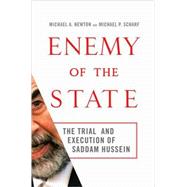
Michael A. Newton is a West Point graduate who serves as Professor of the Practice of Law at Vanderbilt University Law School. During his distinguished military career, Lieutenant Colonel (Ret.) Newton served in both the Clinton and Bush administrations as Advisor to the Ambassador-at-Large for War Crimes Issues at the U.S. Department of State, where he played a key role in negotiating the Statutes of the Special Court for Sierra Leone and the Elements of Crimes for the International Criminal Court. Newton advised Iraqi jurists as they drafted the Statute for the Iraqi High Tribunal, provided training to the Tribunal’s judges, and shuttled back and forth to Baghdad to provide assistance to the judges during the trial of Saddam Hussein.
Michael P. Scharf is Professor of Law and Director of the Frederick K. Cox International Law Center at Case Western Reserve University School of Law. As Attorney-Adviser for United Nations Affairs at the U.S. Department of State during the elder Bush and Clinton administrations, Scharf was instrumental in the establishment of the Yugoslavia Tribunal. In February 2005, Scharf and the Public International Law and Policy Group, an NGO he cofounded, were nominated for the Nobel Peace Prize by six governments and the Prosecutor of an International Criminal Tribunal for the work they have done to help in the prosecution of major war criminals, including Slobodan Milosevic, Charles Taylor, and Saddam Hussein.
| Acknowledgments | p. ix |
| Prologue: High Crimes, High Drama | p. 1 |
| Liberation | p. 9 |
| The Genesis of Justice | p. 23 |
| Hammurabi was an Iraqi: The Creation of the Iraqi Tribunal | p. 35 |
| Proving Incredible Events | p. 64 |
| Trial and Error | p. 83 |
| Disorder in the Courtroom | p. 106 |
| Judgment Day | p. 171 |
| Appeal and Execution | p. 184 |
| Echoes of Nuremberg: The Dujail Trial in Historic Perspective | p. 207 |
| Conclusion | p. 219 |
| Epilogue | p. 235 |
| A Time Line of Events Related to the Dujail Trial | p. 239 |
| Glossary of Key Legal Terms | p. 249 |
| Notes | p. 265 |
| Index | p. 289 |
| Table of Contents provided by Ingram. All Rights Reserved. |
The New copy of this book will include any supplemental materials advertised. Please check the title of the book to determine if it should include any access cards, study guides, lab manuals, CDs, etc.
The Used, Rental and eBook copies of this book are not guaranteed to include any supplemental materials. Typically, only the book itself is included. This is true even if the title states it includes any access cards, study guides, lab manuals, CDs, etc.
Excerpted from Enemy of the State: The Trial and Execution of Saddam Hussein by Michael A. Newton, Michael P. Scharf
All rights reserved by the original copyright owners. Excerpts are provided for display purposes only and may not be reproduced, reprinted or distributed without the written permission of the publisher.